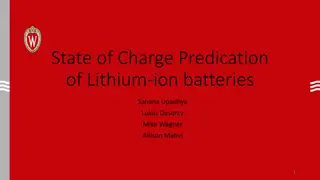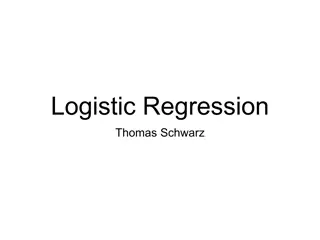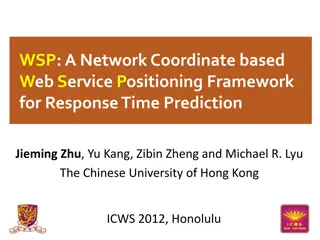Address Prediction and Recovery in EECS 470 Lecture Winter 2024
Explore the concepts of address prediction, recovery, and interrupt recovery in EECS 470 lecture featuring slides developed by prominent professors. Topics include branch predictors, limitations of Tomasulo's Algorithm, various prediction schemes, branch history tables, and more. Dive into bimodal,
0 views • 42 slides
System Models in Software Engineering: A Comprehensive Overview
System models play a crucial role in software engineering, aiding in understanding system functionality and communicating with customers. They include context models, behavioural models, data models, object models, and more, each offering unique perspectives on the system. Different types of system
5 views • 33 slides
Missouri State Highway Patrol - Uniform Crash Report Training Overview
This content provides an overview of the Missouri State Highway Patrol's training on the Missouri Uniform Crash Report (MUCR) revision process, stakeholders involved, objectives, reasons for revising the crash report, and the relevance of the Model Minimum Uniform Crash Criteria (MMUCC). It covers t
7 views • 173 slides
Overview of Distributed Systems: Characteristics, Classification, Computation, Communication, and Fault Models
Characterizing Distributed Systems: Multiple autonomous computers with CPUs, memory, storage, and I/O paths, interconnected geographically, shared state, global invariants. Classifying Distributed Systems: Based on synchrony, communication medium, fault models like crash and Byzantine failures. Comp
10 views • 126 slides
H.264/AVC: Key Concepts and Features
Exploring the fundamentals of MPEG-4 Part 10, also known as H.264/AVC, this overview delves into the codec flow, macroblocks, slices, profiles, reference picture management, inter prediction techniques, motion vector compensation, and intra prediction methods used in this advanced video compression
4 views • 32 slides
Models of Teaching for Effective Learning
Models of teaching serve as instructional designs to facilitate students in acquiring knowledge, skills, and values by creating specific learning environments. Bruce Joyce and Marsha Weil classified teaching models into four families: Information Processing Models, Personal Models, Social Interactio
1 views • 28 slides
Survive Winter Plane Crash - Team Problem Solving Game Overview
Engage in the 'Survive Winter Plane Crash' team problem-solving game to learn about collaboration, prioritization, and group dynamics. Navigate a scenario of survival in Northern Canada after a plane crash, where you must rank and prioritize items for your survival. Suitable for staff, quality impro
0 views • 17 slides
Advancements in Air Pollution Prediction Models for Urban Centers
Efficient air pollution monitoring and prediction models are essential due to the increasing urbanization trend. This research aims to develop novel attention-based long-short term memory models for accurate air pollution prediction. By leveraging machine learning and deep learning approaches, the s
1 views • 17 slides
Crash Investigation Procedures
Crash investigation is a crucial element in incident management at crash scenes. It involves determining the cause and details of traffic crashes, with collected information used by various stakeholders such as traffic engineers and insurance companies. Law enforcement officers play a vital role in
0 views • 16 slides
State of Charge Prediction in Lithium-ion Batteries
Explore the significance of State of Charge (SOC) prediction in lithium-ion batteries, focusing on battery degradation models, voltage characteristics, accurate SOC estimation, SOC prediction methodologies, and testing equipment like Digatron Lithium Cell Tester. The content delves into SOC manageme
0 views • 32 slides
KFRE: Validated Risk Prediction Tool for Kidney Replacement Therapy
KFRE, a validated risk prediction tool, aids in predicting the need for kidney replacement therapy in adults with chronic kidney disease. Developed in Canada in 2011, KFRE has undergone validation in over 30 countries, showing superior clinical accuracy in KRT prediction. Caution is advised when usi
0 views • 9 slides
Crash Carts and Their Importance in Medical Emergencies
Crash carts, also known as code carts, are vital in medical settings for providing emergency medical equipment and drugs to resuscitate patients experiencing cardiac arrest. These carts play a crucial role in supporting life-saving protocols and improving efficiency in emergencies, ultimately increa
2 views • 17 slides
The Role of Corps Safety Engineering Office in Enhancing Road Safety
The Corps Safety Engineering Office (CSEO) was established to professionalize engineering services and improve road safety in Nigeria. It offers support in vehicle inspection, traffic management, and crash investigation. CSEO operates under the FRSC (Establishment) Act 2007, focusing on Traffic Engi
0 views • 18 slides
Real-time Experimental Lightning Flash Prediction Report
This Real-time Experimental Lightning Flash Prediction Report presents a detailed analysis of lightning flash forecasts based on initial conditions. Prepared by a team at the Indian Institute of Tropical Meteorology, Ministry of Earth Sciences, India, the report includes data on accumulated total li
0 views • 6 slides
Privacy-Preserving Prediction and Learning in Machine Learning Research
Explore the concepts of privacy-preserving prediction and learning in machine learning research, including differential privacy, trade-offs, prediction APIs, membership inference attacks, label aggregation, classification via aggregation, and prediction stability. The content delves into the challen
1 views • 11 slides
Wetland Prediction Model Assessment in GIS Pilot Study for Kinston Bypass
Wetland Prediction Model Assessment was conducted in a GIS pilot study for the Kinston Bypass project in Lenoir County. The goal was to streamline project delivery through GIS resources. The study focused on Corridor 36, assessing various wetland types over a vast area using statistical and spatial
0 views • 16 slides
KYTC District 6 Great Eight Incident Management Task Force Meeting Recap
Recap of the KYTC District 6 Great Eight Incident Management Task Force meeting held on July 9, 2013. The meeting covered incident reviews including a truck fire and fuel spill in Harrison County, responsibilities for debris removal after a truck/camper crash in Carroll County, a two semi crash in G
1 views • 44 slides
Clipper: A Low Latency Online Prediction Serving System
Machine learning often requires real-time, accurate, and robust predictions under heavy query loads. However, many existing frameworks are more focused on model training than deployment. Clipper is an online prediction system with a modular architecture that addresses concerns such as latency, throu
0 views • 17 slides
Development of Crash Severity Models for Highway Safety Manual
Research findings from NCHRP Project 17-85 focused on assessing current HSM approaches for crash severity prediction, identifying gaps, developing new severity models, and creating guidance for model application. The study introduced distinctive methodologies like Quasi-induced Exposure and Ordered
0 views • 19 slides
Impact of Vehicle Mix on Crash Frequency and Severity
The supplemental presentation to NCHRP Research Report 1103 explores the influence of vehicle mix on crash frequency and severity. It highlights the project background, objectives, completed tasks, key deliverables, implementation strategies, and considerations for the Highway Safety Manual. The pro
0 views • 43 slides
Theoretical Justification of Popular Link Prediction Heuristics
This content discusses the theoretical justification of popular link prediction heuristics such as predicting connections between nodes based on common neighbors, shortest paths, and weights assigned to low-degree common neighbors. It also explores link prediction generative models and previous empi
0 views • 39 slides
Using Decision Trees for Program-Based Static Branch Prediction
This presentation discusses the use of decision trees to enhance program-based static branch prediction, focusing on improving the Ball and Larus heuristics. It covers the importance of static branch prediction, motivation behind the research, goals of the study, and background on Ball and Larus heu
0 views • 36 slides
Binary Outcome Prediction Models in Data Science
Categorical data outcomes often involve binary decisions, such as re-election of a president or customer satisfaction. Prediction models like logistic regression and Bayes classifier are used to make accurate predictions based on categorical and numerical features. Regression models, both discrimina
0 views • 67 slides
Unveiling the Black Box: ML Prediction Serving Systems
Delve into the world of Machine Learning Prediction Serving Systems with a focus on low latency, high throughput, and minimal resource usage. Explore state-of-the-art models like Clipper and TF Serving, and learn how models can be optimized for performance. Discover the inner workings of models thro
0 views • 30 slides
Multivariate Statistics: Regression, Correlation, and Prediction Models
Explore the differences between regression and correlation, learn about compensatory prediction models, understand the role of suppressor and moderator variables, and delve into non-compensatory models based on cutoffs in multivariate statistics.
0 views • 9 slides
Development of Roundabout Crash Prediction Models and Methods
This project focuses on developing Crash Prediction Models (CPMs) for U.S. roundabouts to enhance planning and design decisions. Geometric and operational features, as well as driver learning curves, are analyzed to understand their impact on crash severity. Data collected from various states forms
0 views • 40 slides
Minnesota E-Crash Train the Trainer Course Overview
Explore the Minnesota E-Crash Train the Trainer Course, approved by the Department of Public Safety and Post Board for continuing education credit. Learn about the purpose of the training, the Minnesota E-Crash application, and highlights including Quick Capture and Built-in Map-It components. Get i
0 views • 12 slides
Overview of Synthetic Models in Transcriptional Data Analysis
This content showcases various synthetic models for analyzing transcriptome data, including integrative models, trait prediction, and deep Boltzmann machines. It explores the generation of synthetic transcriptome data and the training processes involved in these models. The use of Restricted Boltzma
0 views • 14 slides
Network Coordinate-based Web Service Positioning Framework for Response Time Prediction
This paper presents the WSP framework, a network coordinate-based approach for predicting response times in web services. It explores the motivation behind web service composition, quality-of-service evaluation, and the challenges of QoS prediction. The WSP framework enables the selection of web ser
0 views • 30 slides
CloudScale: Elastic Resource Scaling for Multi-Tenant Cloud Systems
CloudScale is an automatic resource scaling system designed to meet Service Level Objective (SLO) requirements with minimal resource and energy cost. The architecture involves resource demand prediction, host prediction, error correction, virtual machine scaling, and conflict handling. Module 1 focu
0 views • 37 slides
Amendments to WIPPS Manual for Climate Prediction at INFCOM-3, April 2024
The document discusses amendments to the Manual on WIPPS for climate prediction, including new recommendations for weather, climate, water, and environmental prediction activities. It introduces concepts such as Global Climate Reanalysis and the coordination of multi-model ensembles for sub-seasonal
1 views • 10 slides
Protein Secondary Structure Prediction: Insights and Methods
Accurate prediction of protein secondary structure is crucial for understanding tertiary structure, predicting protein function, and classification. This prediction involves identifying key elements like alpha helices, beta sheets, turns, and loops. Various methods such as manual assignment by cryst
0 views • 30 slides
Analysis of School Bus Crash Statistics in Ohio
Explore the statistics and findings from crashes involving school buses in Ohio, including comparisons with teen driver crashes, crash information, driver and occupant injuries, and definitions of injuries. Sergeant Trevor Jasper, as the Crash Reconstruction Supervisor from the Ohio State Highway Pa
1 views • 10 slides
In-Service Performance Evaluation of Crash Cushions and Guardrail Approach Terminals
In-Service Performance Evaluations (ISPE) assess the safety performance of crash cushions and guardrail approach terminals installed on roads. This evaluation involves data gathering and analysis in collaboration with various offices to ensure road safety. The FHWA recommendation prompted the initia
0 views • 21 slides
Bringing Police Crash Investigation into the 21st Century: Advancing Technologies for Enhanced Reporting
National Transportation Safety Board should advocate for modernizing how State and Local Police investigate and report on motor vehicle crashes. New technologies like laptops, digital cameras, black boxes, and AI programs can significantly improve the accuracy and completeness of crash reports. Adop
0 views • 16 slides
Analysis and Comparison of Wave Equation Prediction for Propagating Waves
Initial analysis and comparison of the wave equation and asymptotic prediction of a receiver experiment at depth for one-way propagating waves. The study examines the amplitude and information derived from a wave equation migration algorithm and its asymptotic form. The focus is on the prediction of
0 views • 23 slides
Evaluation of Clinical Prediction Models Using Net Benefit versus ROC Curves
Performance evaluation of clinical prediction models involves comparing predicted outcomes with ground truth data using ROC curves. The area under the ROC curve (AUC) is commonly used to assess model performance. A novel method for comparing different models is proposed. Decision-making on treatment
0 views • 22 slides
Proposed Guidance for Fixed Objects in Roadside Design
This presentation covers the development of design guidance aimed at mitigating collisions with roadside fixed objects, focusing on trees and utility poles. With a high number of traffic fatalities resulting from roadway departures involving such objects, the research objective is to provide enginee
0 views • 22 slides
Update of Crash Modification Factors for Highway Safety Manual
This project, led by the University of North Carolina Highway Safety Research Center, focuses on updating Crash Modification Factors (CMFs) for the Highway Safety Manual (HSM). The team aims to assess and develop criteria for CMFs, conduct gap analysis, develop crash modification functions for treat
0 views • 36 slides
Utilizing Crash Modification Factors in ODOT Safety Application Process
Explore how the Ohio Department of Transportation (ODOT) integrates Crash Modification Factors (CMFs) in benefit/cost analysis and project prioritization. Learn about the ODOT Safety Application Process, CMF application, project development, location selection, crash data analysis, countermeasure se
0 views • 16 slides







































